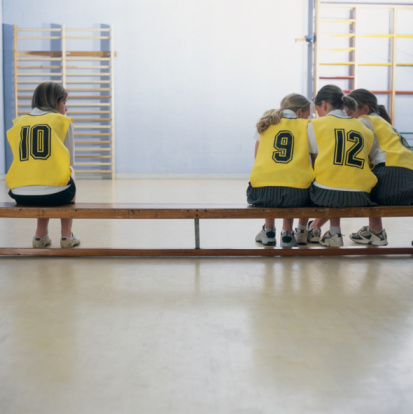Although April - which was both National Youth Sports Safety Month and National Child Abuse Prevention Month - is now over, it doesn't mean that the work of parents in helping keep kids safer playing sports is over.
Indeed, as I have learned over the past 25 years, first as a mother, coach, administrator, and youth sports safety activist, then as the Founder and Publisher of MomsTEAM, and now as the Executive Director of the non-profit MomsTEAM Youth Sports Safety Institute, I have learned that, just as it takes a village to raise a child, it takes the continued involvement of every youth sports stakeholder to protect children at play from abuse -- not just physical abuse, but emotional, psychological and sexual -- and from sports injuries, many of which are preventable.
While the Federal Child Abuse Prevention and Treatment Act (CAPTA), provides guidance to states by identifying a minimum set of acts or behaviors that define child abuse and neglect, there are no federal, and very few state laws (outside the realm of concussion safety), which specifically protect children involved in sports; fewer still penalize those that violate its provisions.
But new child protection laws aren't the only way to help improve youth sports safety. There are numerous steps that parents can take, along with other like-minded parents, to make the sports experience safer for all children in their local communities. Here are just six:
1. Push your school and community-based programs to adopt comprehensive risk management programs. If concern is expressed that implementing such a program could end up increasing the exposure to lawsuits because any deficiency or oversight in meeting self-imposed safety requirements could provide the basis for a negligence lawsuit, help the club or school board understand that such fear shouldn't be an impediment to implementation. The alternative is worse: without such safety programs, more kids are likely to get hurt.

2. Lobby your community to use the power of the permit. In most places, youth sports organizations (YSOs) don't own their own facilities; they use taxpayer-funded fields, diamonds, tracks, pools, and courts instead. To use them they have to obtain permits.
In my 2006 book, Home Team Advantage: The Critical Role of Mothers in Youth Sports, I argued that, "By utilizing the power of the venue permits, a municipality can reform youth sports by exercising public oversight over the use of taxpayer-funded fields, diamonds, tracks, pools, and courts, denying permits to programs that fail to abide by" municipal ordinances with respect to sports injury prevention and treatment.
It is a power, as University of Missouri Law professor Doug Abrams noted during a presentation at MomsTEAM's September 2014 youth sports safety summit, in a subsequent article on MomsTEAM, in a law review article, and in a recent Huffington Post blog, that has been a "bedrock principle of municipal law" for decades.
And it works.
When her efforts to get the Connecticut state legislature to expand the coverage of its youth sports concussion safety law to cover private sports organizations stalled, a concussion safety activist, armed with information about the power of the permit I had provided to her in an email, was able to successfully lobby the city council in Norwalk, Connecticut to use the power of the permit to force organized youth sports programs utilizing the city's recreational facilities to abide by the state concussion guidelines.
3. Take a public stand against hazing and push for adoption by your child's sports program of a strict anti-hazing policy. The policy emphasized in pre-season meetings and written materials distributed to every student/team member, and, above all, enforced.
4. Push for youth sports organizations to adopt a public health approach to injury prevention. Dr. Jim MacDonald, a clinical professor at Ohio State and pediatric sports medicine specialist at Nationwide Children's Hospital, urges a comprehensive approach to preventing youth sports injuries based on three proven public health strategies: (1) "thinking like Sweden" in setting a target of zero youth sports injuries; (2) encouraging greater use of personal protective equipment shown to reduce injury risk, including properly fitted and maintained helmets, and the wearing of mouth guards and goggles in a wide range of sports; and (3) recognizing that education is not enough to change the cultural and physical environment of youth sports, but requires active implementation of sports safety best practices, including more certified athletic trainers, not just in high school sports but at the middle school and youth level; and by doing a better job of getting high school and youth coaches to "buy" into injury prevention.
5. Ask for safety training of coaches and mandatory evaluations. The United States is the only country in the major sporting world that does not have a national coaching education program. With all the money being poured into youth sports, it is simply astounding that the least investment is in coaches, even though they usually have the most impact on kids and keeping them safe.
6. Call for community-, private- and school-based sports organizations to view youth sports safety from a child's rights perspective. Children playing sports are owed a duty of care. Encourage programs to identify best youth sports health and safety practices and implement child protection programs to combat physical, emotional and sexual abuse in youth sports, as has been done in the United Kingdom. Because such programs implement standards that apply to everyone, not just parents, but coaches, players, officials, and other adults who work with children in sports, they won't just reduce the number of out-of-control parents, but the number of out-of-control, abusive coaches, team-bullies, spectators, and volunteers as well.
Brooke de Lench is Executive Director of MomsTEAM Youth Sports Safety Institute, Founder and Publisher of MomsTEAM.com, Producer/Director of The Smartest Team: Making High School Football Safer, and author of Home Team Advantage: The Critical Role of Mothers in Youth Sports (HarperCollins). You can follow Brooke on Twitter @brookedelench.



















